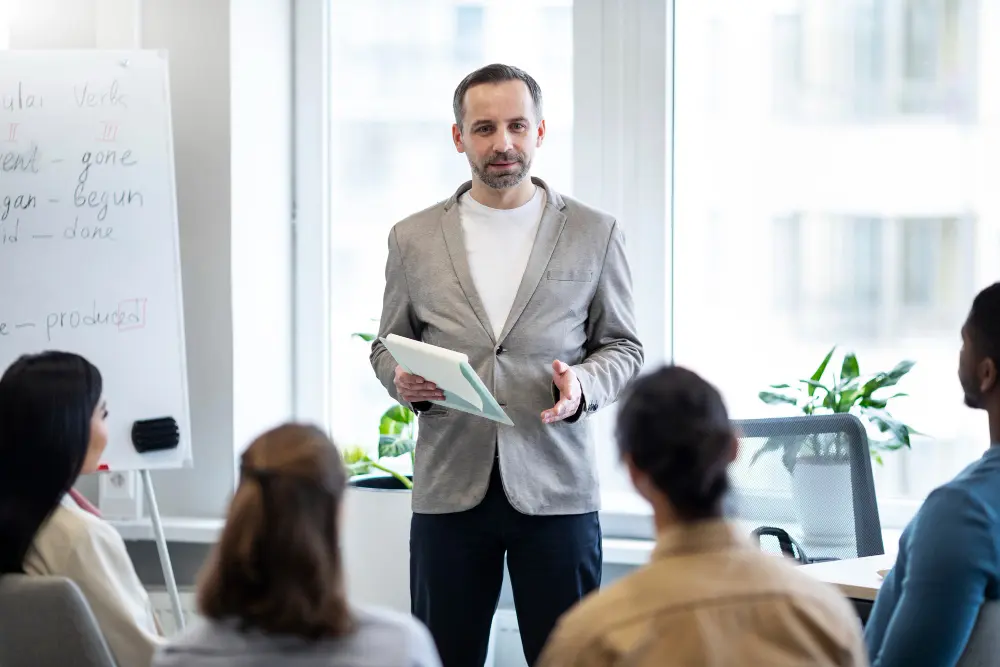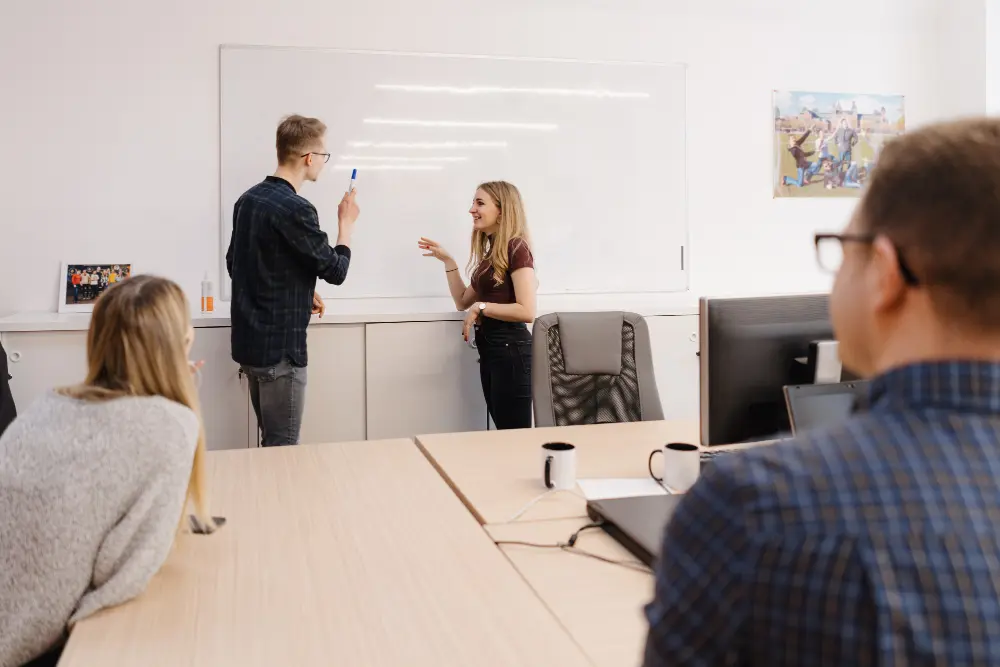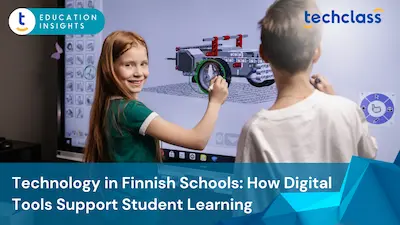.png)
Finland has long been celebrated as a global leader in education, a nation where learning is not simply about acquiring knowledge, but about discovering purpose. One of the most remarkable aspects of Finland’s education system is its deep integration of entrepreneurship education, where creativity, problem-solving, and innovation are cultivated from the earliest years of schooling.
Entrepreneurship Education in Finland is more than learning how to start a business. It is about learning how to think differently, act responsibly, and make an impact. In every Finnish classroom, students are encouraged to take ownership of their ideas, transform them into practical projects, and contribute to their communities. This approach nurtures not only entrepreneurs but also innovative thinkers, empathetic leaders, and lifelong learners.
The world increasingly looks to Finland for guidance on how to prepare young people for an uncertain future. Through TechClass, international educators, school managers, and policymakers can witness this transformation firsthand by visiting schools in Finland and learning from the system that makes creativity part of everyday education.

The success of entrepreneurship education in Finland begins with a strong philosophical foundation. Finnish education operates on three timeless principles: trust, equality, and creativity. These values are not simply words on paper; they guide every decision, from classroom design to national curriculum development.
Unlike many systems that focus on standardized testing, Finland emphasizes education as a means to nurture the whole person. Students are encouraged to explore their passions, question assumptions, and apply knowledge to real-world situations. In this environment, entrepreneurial thinking naturally emerges. A student who learns to identify a community problem and design a creative solution gains skills that go far beyond the classroom.
In Finland, entrepreneurship is not a separate subject; it is a mindset woven throughout all disciplines. Whether students are designing sustainable products in science class or running a local café project as part of a business course, they learn resilience, initiative, and teamwork. The Finnish National Agency for Education (EDUFI) describes entrepreneurship education as developing the ability to act creatively and responsibly in an ever‑changing world. It’s about teaching students to see possibilities where others see obstacles.

Teachers in Finland are trusted professionals. They are given freedom to adapt lessons, experiment with methods, and design projects that spark curiosity. Students, in turn, are given autonomy to take initiative in their learning. This mutual trust forms the foundation of innovation - when learners feel safe to fail, they also feel free to innovate. For educators worldwide, this philosophy represents a powerful lesson: innovation thrives not through pressure, but through freedom, support, and trust.
Finnish schools prioritise kindness, responsibility, and civic participation. Entrepreneurship education channels these values into social entrepreneurship and sustainability projects. Students learn that viable ideas should also be ethical, inclusive, and environmentally mindful. In practice, this means designing use‑cases that serve communities: a student‑run repair café, a peer‑mentoring platform, or a school garden with a micro‑business plan to fund local causes.
Entrepreneurship education in Finland is a lifelong journey. It starts with play and exploration in early childhood and evolves into innovation and leadership by university level. Every stage builds on the previous one, creating a continuous pathway from curiosity to impact.
In Finnish early education, play is the foundation of learning. Children experiment, imagine, and collaborate - key elements of creative thinking. Teachers act as facilitators, helping students connect their ideas to real‑world contexts. Activities such as classroom “shops,” role‑playing games, or community art projects introduce the basics of decision‑making and problem‑solving. These small exercises plant the first seeds of entrepreneurial behavior: curiosity, responsibility, and initiative.
Classroom snapshot: A preschool group designs a pretend bakery. They name it, create a logo with crayons, decide who is a baker or cashier, practice counting, and discuss what happens to unsold bread. Through play, they meet mathematics, language, and ethics in an integrated way.
As children move into basic education (grades 1–9), projects become richer and longer. Teachers introduce phenomenon‑based learning, where topics cut across subjects. A unit on clean water might include science experiments, persuasive writing to the local council, and a small fundraiser to support a water charity. Students pitch their ideas to classmates, receive feedback, and iterate - a simple but meaningful version of the entrepreneurial cycle.

By the time students reach lower and upper secondary education, schools emphasise interdisciplinary learning. Instead of separating subjects, teachers integrate them into projects that tackle real challenges. A science lesson might become a sustainability startup project; a history class might explore innovation in ancient societies. One of the best‑known examples is Me & MyCity, an award‑winning Finnish learning concept that allows students to manage a miniature city, take on professional roles, and understand how the economy and society function. Through these experiences, students learn teamwork, leadership, and accountability, all vital entrepreneurial qualities.
Student journey example: A group investigates food waste in the school cafeteria. They collect data, interview staff, calculate costs, and prototype a “smart portion” campaign with gentle nudges and signage. The result? Less waste, happier students, and a practical lesson in design thinking.
At the vocational and university levels, the focus shifts to real‑world entrepreneurship. Institutions such as Haaga‑Helia University of Applied Sciences and Aalto University have developed models where students create actual startups as part of their studies. They collaborate with industry partners, pitch to investors, and learn by doing. Courses are often organised around real clients, with deliverables that matter outside the classroom. This approach strengthens Finland’s startup ecosystem and ensures that young people graduate with confidence, creativity, and a deep sense of purpose.
Pathway in practice: First‑year students explore opportunity spotting and user research. Second‑year students run a trial company through a mini‑incubator. Final‑year students polish business models, seek partnerships, and potentially register their ventures.
Entrepreneurship does not end with a diploma. Adult education centres, municipal innovation programs, and alumni networks provide mentoring, workspace, and peer support to foster continuous innovation. Graduates often join startup accelerators, serve as advisors for student projects, and collaborate with local businesses to launch community initiatives. They also return to schools as mentors and guest lecturers, sharing lessons learned from real-world ventures, closing the loop, and enriching the next generation’s learning with practical insight and inspiration.
Finland’s strength lies not only in what happens inside classrooms but also in the ecosystem that connects education, business, and society. It’s a national effort where schools, local communities, and industries work together to promote innovation.
The Triple Helix model refers to a framework for innovation that emphasizes interaction and collaboration between universities (education), industry (business), and government. Each sector supports and complements the others, creating an environment where knowledge is transferred efficiently and innovations can flourish. This concept helps explain how Finland aligns education, research, and entrepreneurship policy to foster innovation-driven growth.. This model goes beyond simple cooperation - it is a structured partnership designed to exchange knowledge, share resources, and co-create innovations. Schools partner with municipalities, local companies, and national agencies to bring authentic entrepreneurial experiences to students. Government entities provide strategic support and policy alignment, businesses contribute mentorship, internships, and funding opportunities, while educational institutions serve as living laboratories for ideas. This approach keeps learning relevant and dynamic, opening doors for internships, mentorship, and community projects. It ensures that students see how innovation flows between research, regulation, and enterprise - a model of interconnected progress that strengthens Finland’s social and economic fabric.
In cities like Helsinki and Tampere, local innovation hubs invite students to participate in workshops, hackathons, and community challenges. These hubs often connect with schools to identify regional challenges, ranging from environmental sustainability to digital inclusion. Helsinki Education Hub enables teachers and students to co‑create educational technology solutions alongside startups, helping them test prototypes and design user‑centric products. Regional Enterprise Agencies support young founders by offering seed funding, business coaching, and networking sessions with experienced entrepreneurs. Many regions have introduced ‘Mini‑Accelerator’ programs specifically tailored for high school and vocational students to refine their startup ideas. Through these networks, the classroom becomes a launchpad for innovation and civic impact, while local economies benefit from fresh youth‑driven perspectives.

Government‑supported programs such as Business Finland provide resources and mentorship to help students and educators transform ideas into enterprises. The Ministry of Education and Culture regularly collaborates with innovation agencies to integrate entrepreneurship into curricula across all education levels. Finland’s National Entrepreneurship Strategy for Education aligns policies to create continuity between school projects and national innovation goals. Events like Slush, one of the world’s largest startup gatherings, and Kasvu Open, Finland’s growth‑company competition, showcase the country’s vibrant startup culture - one that starts in classrooms and expands globally. International delegations routinely visit to observe how these partnerships elevate teaching and learning, reinforcing Finland’s reputation as a cradle of creativity and applied innovation.
Schools often adopt a “challenge brief” from a local partner: redesign a town square, improve cycling safety, or create a micro‑campaign for a cultural festival. These partnerships are carefully structured, blending academic learning with community engagement. Students interview stakeholders, test prototypes, and present findings in public forums that attract parents, citizens, and business leaders. Projects frequently evolve into civic initiatives or local start‑ups, giving students firsthand experience of social impact and entrepreneurship. Teachers act as facilitators, ensuring projects remain inclusive, ethical, and aligned with curricular goals. These experiences build confidence, nurture accountability, and show that young people can shape their communities today - not someday.
Behind every successful student project is an empowered teacher. In Finland, teachers are seen as architects of innovation - not mere instructors, but mentors guiding students through discovery.
Rather than delivering fixed lessons, Finnish teachers design learning environments that encourage questioning and experimentation. Their role extends beyond instruction - they act as mentors, motivators, and co-learners who help students explore problems from multiple perspectives. Teachers use inquiry-based approaches, design challenges, and project-based learning to make lessons dynamic and relevant. They model entrepreneurial behavior themselves - showing resilience, adaptability, and creativity in their daily teaching. By doing so, they demonstrate to students that innovation is an ongoing process of reflection, iteration, and collaboration.
All Finnish teachers hold a master’s degree, and their education emphasizes both pedagogy and research. They are trained to reflect critically, test new ideas, and continuously improve their teaching. This research orientation ensures that every educator becomes both a practitioner and a scholar, capable of grounding decisions in evidence rather than routine. Student teachers engage in classroom-based research, exploring questions like how to improve collaboration or how digital tools influence motivation. Universities foster partnerships with local schools, creating living laboratories where theory and practice meet. Teachers graduate with the analytical mindset to evaluate outcomes, share findings, and adapt to future challenges. This culture of professional autonomy ensures that innovation is not a trend but a tradition, embedded in Finland’s educational DNA.

Professional development in Finland is ongoing, dynamic, and self‑directed. Teachers participate in peer networks, innovation labs, and collaborative workshops designed to sustain curiosity and develop practical skill. They are encouraged to continuously refresh their methods through reflective practice, classroom experimentation, and cross-disciplinary projects. Many educators engage in pedagogical research groups, attend summer universities, and present at national and international education conferences, fostering a vibrant culture of exchange. National forums such as the Finnish Association of Teachers serve as meeting grounds where ideas about new teaching methods, inclusivity, and educational technology are openly discussed.
Programs such as the Oulu Teacher Training School encourage educators to integrate entrepreneurship education into every subject, providing structured mentoring, lesson design templates, and collaborative reflection sessions that spread creative practice nationwide. Teachers are also supported through grants to pursue international fellowships, take part in EU-funded innovation programs, and engage in cross-border collaborations that broaden their perspectives. Many contribute to academic journals or practitioner magazines, ensuring that Finland’s teaching community remains globally connected and forward-thinking.
Lifelong learning in Finland is therefore not merely a policy expectation but a deeply rooted professional ethic - a commitment to continuous personal growth, collective innovation, and the shared mission of preparing future generations for an evolving world.
Feedback in entrepreneurial projects is dialogic: teachers and students co‑analyse what worked, what failed, and what to try next. Instead of a one‑way critique, this dialogue invites mutual reflection, where both sides uncover insights and identify growth opportunities. Teachers use questioning strategies such as “What evidence supports this idea?” or “How might we approach this differently next time?” to guide learners toward deeper thinking. Reflection journals and short learning talks help students name strategies, assess emotional responses to challenges, and transfer lessons to new contexts. Group reflection circles at the end of each project encourage students to celebrate progress, recognize collaboration, and set actionable goals for improvement. This coaching stance builds metacognition - the engine of independent, innovative learning - while also strengthening confidence and communication skills essential for entrepreneurial success.
The physical environment plays a major role in Finland’s education success. Schools are designed to promote creativity, collaboration, and comfort - essential conditions for innovation.
Classrooms are flexible and student‑centered. Desks can be rearranged, walls invite brainstorming, and technology enhances access to global resources. Finnish learning spaces are calm yet dynamic, reflecting the belief that learning should be enjoyable and purposeful. Many schools integrate sustainability principles, encouraging students to design eco‑friendly spaces and learn about environmental responsibility through action.
Makerspaces and studios give students access to tools: microcontrollers, 3D printers, sewing machines, and podcast corners. These tools do not drive learning; rather, they enable prototypes and storytelling that bring ideas to life. When students can build and share, they begin to think like designers and entrepreneurs.

The most powerful evidence of success comes from students themselves. Across Finland, young people are translating classroom concepts into real‑world ventures.
One such example is Nuori Yrittäjyys ry (Junior Achievement Finland), a national program that supports student‑run enterprises. High‑school students develop business ideas, manage small companies, and even compete internationally. Many continue their ventures after graduation, showing how education can directly spark entrepreneurship.
In another instance, vocational students in Northern Finland launched a community recycling project that grew into a profitable local business. University students at Aalto’s Startup Sauna have built innovations that reached global markets, underscoring how entrepreneurial education creates tangible results.
What these stories share: an authentic problem, a supportive mentor, and the belief that young people can contribute meaningfully. Students see that entrepreneurship is not only about profit; it can be about service, culture, and sustainability.
Finland believes that true success cannot be captured by a number. Instead of emphasizing exams, it focuses on skills, wellbeing, and long‑term growth.
Assessment in Finnish entrepreneurship education is formative and reflective. Students maintain portfolios documenting their learning journeys, projects, and personal growth. Peer evaluations and self‑assessments encourage collaboration and self‑awareness.
The criteria for success are holistic:
This method nurtures confidence, accountability, and motivation. It turns assessment into an empowering process rather than a source of stress — reinforcing Finland’s belief that education is about progress, not perfection.
Evidence over averages: A student’s podcast that persuades a municipality to trial a new idea is evidence. A prototype that fails but reveals clear next steps is evidence. The focus is on documented impact and learning transfer.
Why the World Looks to Finland for Educational Innovation
Educational experts from around the world continue to study Finland’s model because it demonstrates that innovation and equity can coexist. The system balances freedom with responsibility, creativity with structure, and individuality with community spirit.
Organisations such as OECD and UNESCO regularly highlight Finland’s achievements in creative education, wellbeing, and student engagement. Delegations from dozens of countries visit Finnish schools every year to learn how entrepreneurship education can empower students and societies. What sets Finland apart is its human‑centered approach: the belief that education should develop the person as much as the professional. This ensures innovation that is ethical, sustainable, and inclusive.

Schools worldwide can adapt Finland’s approach by embracing a few universal principles:
These steps can be implemented without major resources, proving that the spirit of Entrepreneurship Education in Finland travels well.
Educators often ask: Where do we begin? Below is a practical, high‑level roadmap inspired by Finnish practice.
Create project cycles of 4–8 weeks with clear milestones: discover, define, design, deliver. At the start of each cycle, guide students in setting measurable goals and identifying milestones that connect to learning objectives. Protect dedicated studio time each week for teamwork, mentor check‑ins, and reflection sessions. These meetings allow students to monitor progress, share findings, and adapt strategies collaboratively. Teachers can use weekly sprints or progress boards to visualize momentum and maintain accountability. Short, regular sessions maintain rhythm without overwhelming other subjects, and periodic showcase days motivate students to take ownership of their outcomes.
Partner with local entrepreneurs, NGOs, and community experts to offer structured mentoring opportunities. Mentors can participate virtually or in person to share their professional experiences, review student projects, and provide guidance on real‑world challenges. Establish a consistent feedback routine so that mentorship becomes an integral learning experience rather than a one‑off event. Offer micro‑credentials for specific skills such as pitching, design research, budgeting, project leadership, and ethical decision‑making. Digital badges and certificates motivate students to recognize their achievements and showcase their growing competence. Schools can use micro‑credentials as a bridge between academic learning and professional recognition, helping students articulate and document transferable skills.
Use a four‑dimension rubric: Insight, Initiative, Collaboration, Impact. Each dimension has evidence descriptors students can easily understand. For instance, Insight may include how effectively a student identifies needs and proposes original ideas; Initiative may measure effort, persistence, and self‑direction; Collaboration tracks teamwork, listening, and shared responsibility; while Impact assesses tangible outcomes, reflection, and contribution to community. Co‑create the rubric with the class to ensure fairness and transparency. When students help define what success looks like, they aim higher and develop a deeper understanding of quality work. Teachers can update rubrics across project cycles to reflect evolving skills, turning assessment into a living, adaptive process.
Make projects accessible by offering multiple roles: researcher, designer, storyteller, data analyst, community liaison, or project manager. Entrepreneurship thrives when diverse talents find a place to contribute. Ensure that each student can participate according to their strengths and interests, allowing different learning styles to shine. Encourage peer partnerships that mix skills and backgrounds to simulate real startup teams. Integrate accessibility tools, multilingual communication, and universal design principles to include all learners, including those with special educational needs. Inclusion by design transforms diversity into an engine of creativity, helping every participant feel valued and empowered to innovate.
Q1: Do we need special funding to start?
Not necessarily. Begin with challenges that use existing resources and local partnerships. Many Finnish projects are low‑cost but high‑trust.
Q2: How much teacher training is required?
A growth mindset and a willingness to coach are the essentials. Peer observation and short workshops can kick‑start confidence.
Q3: What if projects fail?
In entrepreneurial learning, failure is feedback. The goal is to learn how to iterate responsibly and communicate insights.
Q4: Can this work in exam‑heavy contexts?
Yes. Align projects with curriculum standards and dedicate regular studio blocks. Evidence generated by projects often strengthens exam performance by deepening understanding.
Q5: How do we involve parents and the community?
Host an open demo day where students share prototypes and stories. Invite feedback and support. Community pride grows when students tackle local challenges.
To truly understand how entrepreneurship education in Finland works, there is no substitute for experiencing it in person. Through TechClass, educators and school leaders can book guided visits to Finnish schools and see how learning, creativity, and innovation come together.
During a visit, participants can observe classes focused on entrepreneurship and innovation, interact with Finnish teachers and students, participate in workshops exploring Finland’s educational philosophy, and learn how to apply similar principles in their own countries. As a Finnish e‑learning provider, TechClass has strong relationships with schools and education experts across Finland. The experience is inspiring and practical - visitors return home with tools, templates, and renewed belief in what students can achieve.
Ready to witness this in action? Book a school visit with TechClass and experience how ideas become impact in Finnish classrooms.
From Ideas to Impact - Building a Better Future through Education
Finland’s story is a powerful reminder that the future belongs to those who can imagine, create, and collaborate. By integrating entrepreneurship education across all levels, Finland has redefined what it means to prepare students for life.
Here, learning is not about competition but contribution. It’s about turning curiosity into confidence, ideas into impact, and dreams into reality. Every Finnish student learns that they have the power to shape their world -and every teacher learns that trust and freedom are keys to unlocking human potential.
If you are an educator, policymaker, or school leader ready to experience this extraordinary system, now is the moment. Join TechClass in Finland and see how a nation of learners continues to inspire the world - one idea at a time.

.webp)
